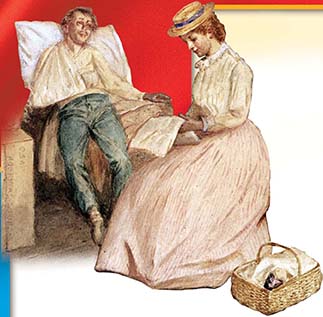SECTION 3: Life During the War

▲ Painting of a Confederate hospital scene

Bottle of medicine used during the Civil War ►
WITNESS HISTORY  AUDIO
AUDIO
The Hardships of War
Mrs. Judith Brockenbrough McGuire, the wife of a high school principal from Alexandria, Virginia, kept a diary that describes daily life in the South throughout the Civil War. Her record of a people under siege highlights the hardships endured by her friends and neighbors as Union soldiers confiscated the supplies they so desperately needed:
“February 11, 1863. For ten days past I have been at the bedside of my patient in Richmond. The physicians for the third time despaired of his life; by the goodness of God he is again [recovering his health]. Our wounded are suffering excessively for tonics, and I believe that many valuable lives are lost for the want of a few bottles of [medicine]…. Oh, how cruel it is that the Northern Government should have made medicines and the necessaries of life to the sick and wounded, contraband articles!”
—Judith Brockenbrough McGuire, Civil War diary
Objectives
- Analyze how the war changed the economy and society in the North and South.
- Discuss how northern and southern soldiers experienced the war.
- Explain the impact of the war on women.
Terms and People
- income tax
- bond
- Homestead Act
- conscription
- Copperhead
- habeas corpus
- inflation
- Clara Barton
NoteTaking
Reading Skill: Compare and Contrast Note the similarities and differences between the northern and southern home fronts during the war.
Why It Matters As African Americans rushed to join the Union ranks, the war dragged on. The fighting brought hard times to the home fronts of both North and South and helped transform many aspects of American life. Between 1861 and 1865, the economy and society of both regions underwent deep and lasting changes. These changes would help launch the North into the modern world, while the South suffered physical and social damage that persisted for decades. Section Focus Question: How did the Civil War bring temporary and lasting changes to American society?
The Home Front in the North
The war had a huge impact on northern industry. For example, the drop in southern cotton production severely damaged the large cotton textiles industry. At the same time, other industries boomed as demand for clothing, arms, and other supplies spiked. To meet the demand, industry became more mechanized.
War Transforms the Northern Economy
Paying to supply the military was a major economic challenge. To help meet the cost, the Union government introduced a tax based on an individual’s earnings. At first, the income tax was 3 percent on all income over $800 a year. As the war continued, the tax was increased. The Union also raised tariffs, which brought in revenue and helped northern industry by raising the cost of imported goods.





